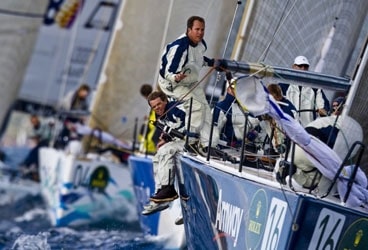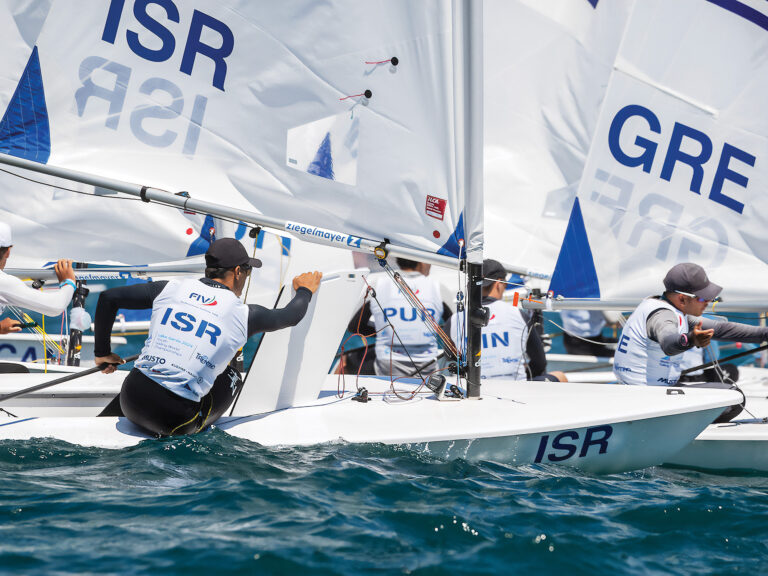
OctFTEKerr369
Picture yourself approaching the weather mark, late on port tack and heading toward a wall of starboard-tack boats. Your team communicates well, you’ve quickly discussed what’s going to happen, and everyone is on the same page; you cross the first three starboard tackers, and then do a smooth duck on the last one before tacking on to the layline. The whole situation seems almost routine-but only because you’ve talked it through.
New teams, and boats with crew that haven’t sailed together for a while would be well served to sit down together and talk about the importance of communication. In my role as a coach I typically sail with a wide variety of teams in a fairly wide variety of classes, and I’ve found it helpful to ask the team I’m sailing with what type of communication they like and how much. I find that it’s particularly important to get on the same page-terminology wise. For example, if we need to communicate a need to sail faster, we might hear any of the following: “bow down, fast forward” by one person, “bear off” by another, “foot mode” by another, and so on.
It’s not uncommon to see communication lapses between a starboard tacker who wants a port tacker to cross. If the port tacker asks to “cross or tack,” make sure everyone knows the response is “cross.” If someone says “no” it could be interpreted as “go” and vice versa. The point is to have everyone agree on the terminology so there is no misunderstanding.
The composition and communication style is different for every team, so the communication channels and the content may be different. But I’ve found that you cannot get too good at this–there are always better, more concise ways of expressing observations. I try to come up with new ways as much as I can both in my role as a coach and in my own sailing. The important thing though, is that those channels are open, and that the team establishes a foundation so that everyone is on the same page and talking their way from start to finish. The challenge of good communication is coming up with ways to get across your observation or idea to the rest of your team in the most efficient and understandable way. Let’s look at a communication model for a five-person keelboat, which can certainly be applied to other boats as well. We’ll break the race in to segments and look at the basic communication roles that each team member has. We’ll assume the tactician in this example is the middle person.
Final approach to the start
The bowman must communicate distance to the line in boatlengths using hand signals and tell the helmsman where other boats are, warning of encroaching boats. An example of this is: “Two boatlengths. Watch bow 32 and 71.” Try to do this off the bow as much as you can; on smaller keelboats crouch at the shrouds.The mastman vocalizes the time countdown clearly. A good technique is to make eye contact with the skipper when calling the time so they’re clear about the time. The middle crew warns the skipper of boats to windward and behind who may try to reach down and overlap to leeward late in the starting sequence. An example might be: “Watch No. 65, he might try to hook us.” The middle crew also relays any VHF broadcasts or flag activity from the race committee.
The cockpit crew, which in this example is also the jib trimmer, warns the skipper of boats approaching from clear astern and boats to leeward, particularly those approaching late on port tack. It’s good practice to point at the boat as well as making eye contact with that other skipper. I have seen top cockpit crews do this: it alerts the skipper to the port tacker, but also communicates to the port tacker that they have been spotted, and defensive action (usually bow down and aiming at them to make them tack early or duck) is inevitable. The cockpit also communicates how much space to leeward there is and when the leeward boats are accelerating.The helmsman communicates whether he wants to go fast, slow, or hold his position. This can be done easily by the words “speed” or “luff.” It should be noted that a bad start typically includes a collective lack of clarity on any one of these aspects–in particular the skipper losing a sense of where the line is at 15 seconds, or the time not being communicated clearly. The challenge of starting, particularly in a big, aggressive fleet, is that it is a series of one-on-one situations that happen in rapid succession, thus the necessity for different teams members to take on concise communication roles.
Useful upwind chatter
The bow communicates puffs, light spots, flatter water, and waves as well as the next mark’s location: “Big puff coming in 3, 2, 1 . . . and it sustains. Mark is at 11 o’clock.” It’s helpful to know if the puff sustains or not, so your team trimmers know how much and how long to de-power the boat if necessary. Calling the lulls and how long they last is just as important.
The bow person is also calling out converging boats: An example of excellent communication would be: “Two starboard tackers, coming about 40 seconds away. Looks like we are bow-to-bow. Do you see them?” Some teams prefer a time estimate and some a boatlength estimate, so find out what the preference is or what is more understandable. For the bow person, using the genoa window is a great tool for judging crossings, so develop your own guide. On a J/24, for example, if the approaching boat is in the forward part of the standard genoa window, they’re likely crossing ahead. If they’re in the middle of the window, they’re likely bow-to-bow with you, and if they’re in the aft part of the window, you’re likely crossing. The mastman helps relay compass numbers, and when the bowman is busy, the mastman takes over calling puffs and waves. This back-up communication is excellent and is one of the hallmarks of the good teams. The middle communicates speed and height versus the competition and overall positioning, and also asks the skipper how the boat feels and communicates to the skipper what mode of the boat should be in, i.e., fast-forward, height mode, or narrow groove. He or she also translates what the compass numbers mean, particularly off the starting line and also rounding the leeward mark. Being specific here is the key element, as is keeping the number of words to a bare minimum.
The cockpit talks with the skipper about genoa trim. “I am at max trim,” or “I’m eased.” And in light air, the trimmer will be sitting to leeward and can verbalize the performance of the boats to leeward and also relay the amount of separation between the team and the leeward boat. This can be particularly helpful off the starting line: “Good gap to leeward you have room to sail fast.”The helmsman, meanwhile, can verbalize the compass numbers as they are in his range of vision and ask for input once in a while if it is not forthcoming. He should talk about how the boat feels and whether there is enough power, and about what mode of sailing is required for the given boat-to-boat and strategic situations.
Keep at it downwind
Very often, teams fall silent going downwind as if they are behind (just like after a bad start), and this is where you have to pick it up, look harder, be more observant, and get every scrap of info that you can to gain places. Keep the dialogue going and maintain an intensity level as if you were in the lead, it will pay dividends. The bow is looking for wind and scanning and verbalizing where the marks are. A good example of good communication and heads-up sailing would be, “Mark is at 11 o’clock, big puff forming up to beam in 3, 2, 1-now.”
For the mast, some good communication here is relaying the compass numbers to the middle and also asking the trimmer and skipper how the pole height is and vang tension looks.
The middle crew is communicating lanes of wind and verbalizing jibing opportunities and fleet performance analysis as well as keeping track of the compass to make sure the team is on the correct jibe. He is talking about the net gains or losses versus boats that are on the other jibe and the angles that the boats behind are sailing. Any concise communication that eloquently states your observation is going to help the team understand what is required and the tactical scenario. The cockpit, which is now trimming the spinnaker, focuses on the sail all the time. The communication from the middle and the dialogue with the skipper paints the picture of where the team is on the racecourse. The trimmer’s communication is continuous with the helm to ensure that the team does not sail too low in the lulls and too high in the puffs.
The focus for the skipper is listening to the crew communication, double-checking where the mark is, and noting compass-heading changes for shifts. If the communication is not forthcoming, then prompt for it by asking questions.









